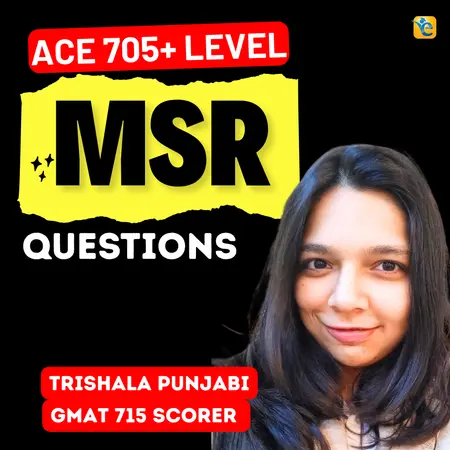Events & Promotions
|
|

GMAT Club Daily Prep
Thank you for using the timer - this advanced tool can estimate your performance and suggest more practice questions. We have subscribed you to Daily Prep Questions via email.
Customized
for You
Track
Your Progress
Practice
Pays
Not interested in getting valuable practice questions and articles delivered to your email? No problem, unsubscribe here.
- Nov 18
11:00 AM PST
-12:00 PM PST
Join us in a live GMAT practice session and solve 30 challenging GMAT questions with other test takers in timed conditions, covering GMAT Quant, Data Sufficiency, Data Insights, Reading Comprehension, and Critical Reasoning questions. - Nov 22
11:00 AM IST
-01:00 PM IST
Do RC/MSR passages scare you? e-GMAT is conducting a masterclass to help you learn – Learn effective reading strategies Tackle difficult RC & MSR with confidence Excel in timed test environment - Nov 23
11:00 AM IST
-01:00 PM IST
Attend this free GMAT Algebra Webinar and learn how to master the most challenging Inequalities and Absolute Value problems with ease. - Nov 25
10:00 AM EST
-11:00 AM EST
Prefer video-based learning? The Target Test Prep OnDemand course is a one-of-a-kind video masterclass featuring 400 hours of lecture-style teaching by Scott Woodbury-Stewart, founder of Target Test Prep and one of the most accomplished GMAT instructors.
Kudos
Bookmarks
C
Be sure to select an answer first to save it in the Error Log before revealing the correct answer (OA)!
Difficulty:
 35%
(medium)
35%
(medium)
Question Stats:
71% (01:58) correct 29%
(02:03)
wrong
29%
(02:03)
wrong  based on 328
sessions
based on 328
sessions
History
Date
Time
Result
Not Attempted Yet
Sarah: some schools seek to foster a habit of volunteering in their students by requiring them to perform community service. But since a person who has been forced to do something has not really volunteered and since the habit of volunteering cannot be said to have been fostered in a person who has not yet volunteered for anything, there is no way this policy can succeed by itself.
Paul: I disagree. Some students forced to perform community service have enjoyed it so much that they subsequently actually volunteer to do something similar. In such cases, the policy can clearly be said to have fostered a habit of volunteering.
Paul responds to Sarah’s argument using which one of the following argumentative techniques?
(A) He argues that Sarah is assuming just what she sets out to prove.
(B) He argues that Sarah’s conception of what it means to volunteer excludes certain activities that ought to be considered instances of volunteering.
(C) He introduces considerations that call into question one of Sarah’s assumptions.
(D) He questions Sarah’s motives for advancing an argument against the school policy.
(E) He argues that a policy Sarah fails to consider could accomplish the same aim as the policy that Sarah considers.
Paul: I disagree. Some students forced to perform community service have enjoyed it so much that they subsequently actually volunteer to do something similar. In such cases, the policy can clearly be said to have fostered a habit of volunteering.
Paul responds to Sarah’s argument using which one of the following argumentative techniques?
(A) He argues that Sarah is assuming just what she sets out to prove.
(B) He argues that Sarah’s conception of what it means to volunteer excludes certain activities that ought to be considered instances of volunteering.
(C) He introduces considerations that call into question one of Sarah’s assumptions.
(D) He questions Sarah’s motives for advancing an argument against the school policy.
(E) He argues that a policy Sarah fails to consider could accomplish the same aim as the policy that Sarah considers.
Kudos
Bookmarks
I'm a little confused between c and e. I chose c but can someone break this down?
Kudos
Bookmarks
Quote:
argument
s= foster by requiring cannot succeed
= if one is forced he is not volunteering
= and one cannot be fostered if he is not volunteering
p= wrong
= some forced to volunteer have volunteered afterwards
= and thus, the habit is fostered
ans (C) he shows that s's claims are questionable, since there is proof against her argument.













